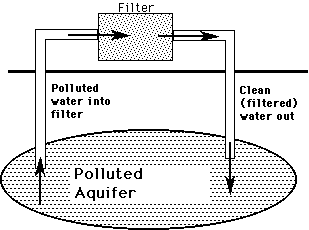Pump & Filter
Pumping and filtering polluted water from an aquifer is a common
way to remove toxic substances from underground. Essentially, a number of
wells into the contaminated aquifer are drilled. Contaminated water is then
pumped to the surface and run through a filter mechanism (not unlike a large
Britta water filter). The contaminant is then filtered out, and fresh, clean
water is returned back into the aquifer. When the filter is full of contaminant,
it is removed and a clean filter is installed. The contaminated filter is
then stored in 55 gallon drums at a toxic waste storage facility.

Cost: about $10 million/ or about $200
extra on tax bill for 10 years.
Pros
1. Relatively inexpensive.
2. Pumps and filters can be installed within weeks or months
on large pollution sites.
2. No air pollution.
3. This is a very safe method.
4. No buildings or structures need to be removed during implementation
of this method.
Cons
1. Must monitor water for years. Some of the toxic chemicals
may continue to spread!
2. Pumping the water could cause the toxic chemicals to spread
more quickly into new areas.
3. This is a slow process. Pumping and filtering may have to
take place for years.
4. The toxic materials that are filtered out must be stored
in a safe place. The prospect of leaking becomes an issue.
